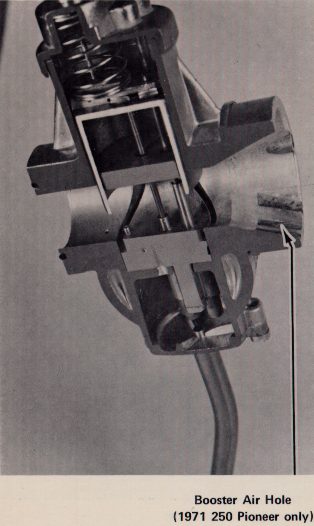
FIG. 127
Page 93
1. From 1/4 to 1/2 throttle, the flow of air is regulated by the throttle slide. As the slide is raised further above the top of the mid-range needle jet, the slide cutaway does not direct air downward on it as effectively. Because of this, a greater vacuum is formed, increasing the amount of fuel drawn from the needle jet.Section 4:
1/4 to 1/2 Throttle: Slide and Mid-Range
Metering System (Fig. 126)
2. At this throttle opening, the needle has been withdrawn halfway from the mid-range needle jet and the mid-range main jet becomes the primary fuel metering device. The needle continues to meter fuel as the slide is raised even further, but the mid-range main jet controls the amount of fuel that is available to flow past the needle.
3. Because the venturi of the carburetor is round, a small upward movement of the slide near or at 1/2 throttle position will allow for a much larger volume of air to flow than the same movement at a higher or lower throttle opening. This creates a greatly increased demand for fuel. The mid-range metering system cannot supply this fuel alone, because only the volume of air flowing over the needle jet has been increased greatly, not the vacuum over it. To compensate for this, a booster system is provided.
4. To boost the flow of fuel, air enters the right-hand small hole beneath
the mouth of the carburetor. This air is routed through a small air jet,
directly into the mid-range needle jet through several small holes drilled
halfway up it. This passage of air up the needle jet boosts the flow of
fuel which is necessary to meet the
demand. Although the booster -system is working at all throttle openings
above idle, it is most effective around 1/2 throttle.
5. On the 1971 250 Pioneer, this booster system is adjustable. Air enters the center small hole beneath the mouth of the carburetor. (Fig. 127) It then flows past a metering screw before going through the small air jet and into the needle jet. Turning this screw clockwise decreases the air flow through the booster system, thereby making the mixture leaner. Turning it counterclockwise increases the air flow, making the mixture richer. (Fig. 128)

FIG. 127
Page 93